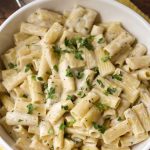 A product made from just the endosperm of the wheat, as most of it is, or from the whole wheat with all the fiber. Other grains may be used. May be colored by using tomato paste or spinach, that is, red or green pasta. Pasta all’uovo is made with eggs. Pasta is generally divided into three main categories: long and folded pasta, noodles, and short pasta. Dried pasta may have a shelf life of up to six months.
A product made from just the endosperm of the wheat, as most of it is, or from the whole wheat with all the fiber. Other grains may be used. May be colored by using tomato paste or spinach, that is, red or green pasta. Pasta all’uovo is made with eggs. Pasta is generally divided into three main categories: long and folded pasta, noodles, and short pasta. Dried pasta may have a shelf life of up to six months.
From the Greek verb passein, meaning to sprinkle or to strew, the ancient Greeks derived their word paste, meaning barley porridge—the connection, presumably, was that the porridge was made by sprinkling barley meal, or nowadays oatmeal, into a pot of boiling water. When the ancient Romans borrowed the Greek paste, they spelt it pasta and used it to mean dough, a paste made from milled grains such as barley. This Latin word gave rise to two different Italian words, pasticcio, the name of a pie made with many ingredients, and pasta, the name of small tubes or shells of cooked dough served with a sauce. Pasticcio was never really adopted by English, but the hodgepodge nature of that Italian pie did give rise to the French word pastiche, meaning a jumble. This French word, pastiche, entered English in the late nineteenth century, about the same time that pasta appeared. Of course, even before English acquired the word pasta from Italian, the British were eating pasta-like foods; however, they referred to any such food as a paste, a word that developed, via French, from the same Latin source as pasta. When paste entered English in the late fourteenth century it was used exclusively as a culinary term: not for another seventy-five years did it come to mean other things, such as glue. Other words that developed directly from either the French or English word paste include pastry, pate, and patty. Pastry is the oldest of these, appearing first in the mid sixteenth century; pate and patty did not appear till the early eighteenth century. Over the last few decades, patty has come to be used in connection with items that contain no dough at all—such as hamburger patty—although its earlier pastry sense is still heard in the children’s rhyme that begins, “Patty-cake, patty-cake, baker’s man.”
The gastronomic marvel known as pasta, hailing originally from the enchanting land of Italy, has traversed its way across borders, now being meticulously crafted in various nations. This culinary delight owes its existence to the cultivation of a robust strain of wheat, commonly referred to as durum wheat, whose resilience finds its zenith in the fertile soil of select Italian regions. In these captivating locales, pasta reigns supreme as the quintessential sustenance, endowing denizens with a cornucopia of vitality, courtesy of its rich reservoirs of energy, protein, as well as a medley of vitamins and minerals. Thus, this remarkable creation takes upon itself the noble task of assuming the mantle that bread so dutifully fulfills in alternate corners of the globe.
